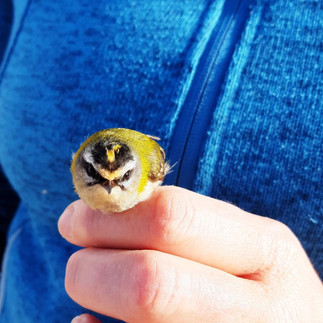Migrazione autunnale. Autumn migration.
- aleliu
- 16 set 2021
- Tempo di lettura: 3 min
Molte delle specie che vengono inanellate presso la nostra stazione di Ponza durante il periodo primaverile, stanno per affrontare o stanno già affrontando la dura migrazione autunnale.
Dopo aver trovato nei diversi ambienti europei e italiani un luogo conforme alla nidificazione, e una volta che anche l'ultima nidiata è cresciuta abbastanza da cavarsela da sola, alcune delle specie come quelle nelle foto sopra si rimettono in viaggio in cerca di condizioni migliori rispetto a quelle che un inverno boreale o continentale potrebbe offrire, dirigendosi verso i quartieri di svernamento più consoni alle loro esigenze.
Le rotte, le tempistiche, le velocità e le distanze della migrazione autunnale dipendono da molti farttori, prima di tutto dalla specie e dalla singola popolazione di uccelli (esiste infatti il fenomeno di 'migrazione parziale' per cui solo una porzione della popolazione migra, mentre l'altra rimane sedentaria nella regione riproduttiva - Berthold, 2001). Altri fattori che possono influenzare le caratteristiche del viaggio autunnale sono le condizioni climatiche durante il tragitto (fra cui anche direzione e intensità del vento e correnti ascensionali), la disponibilità di luoghi di sosta, le caratteristiche dei luoghi di partenza e arrivo e il successo nella fase di preparazione al volo di migrazione.
Molti uccelli sfruttano le ore serali e notturne per migrare e questi comportamenti sono spesso più comuni durante le fasi di luna piena, poichè la luce riflessa del satellite permette una migliore visione dell'ambiente circostante. Ricorderete, infatti, che presso la nostra stazione si sono verificate le cosiddette 'pettirossate' ovvero catture massive di pettirossi nelle ore subito successive al tramonto. Lo stesso accade spesso nella stazione dei nostri colleghi alpini che si occupano dell'inanellamento durante, appunto, la migrazione autunnale: la Stazione di Inanellamento del Monte Pizzoc.
Proprio in questi giorni ci si approccia alla fase di luna piena, auguriamo quindi un buon lavoro agli amici del Pizzoc, che vi consigliamo di seguire tramite il blog, la pagina Instagram o il profilo Facebook!
Con la migrazione autunnale iniziano anche i preparativi per la migrazione primaverile per noi di CISCA, quindi rimanete sintonizzati per le novità della stagione che ci attende l'anno prossimo!
Many of the species that are ringed at our station in Ponza during the spring period are about to face or are already facing the hard autumn migration.
After having found a suitable nesting site in the different European and Italian environments, and once the last brood has grown enough to be independent, some of the species - like those in the photos above - set off again in search of better conditions than to those that a boreal or continental winter could offer, heading towards the wintering areas most suited to their needs.
The routes, timing, speeds and distances of the autumn migration depend on many factors, first of all on the catachteristics of the species and of the single population of birds (there is in fact the phenomenon of 'partial migration' for which only a portion of the population migrates, while the other remains sedentary in the reproductive region - Berthold, 2001). Other factors that can influence the characteristics of the autumn migration are the climatic conditions during the journey (including wind direction and intensity, and updrafts), the availability of places to stop over, the characteristics of the places of departure and arrival, and the success in the preparation phase for the migration flight.
Many birds take advantage of the evening and night hours to migrate and these behaviours are often more common during the phases of the full moon, as the reflected light of the satellite allows a better view of the surrounding environment. You will remember, in fact, that the so-called 'robins wave' occurred at our station, i.e. massive catches of robins in the hours immediately following sunset. The same often happens in the station of our Alpine colleagues who carry out the ringing research activity during the autumn migration: the Ringing Station of Monte Pizzoc.
Precisely in these days we are approaching the full moon phase, so we wish a good job to the friends of Pizzoc, whom we recommend you to follow through the blog, the Instagram page or the Facebook profile!
With the autumn migration, however, preparations for the spring migration also begin for us at CISCA, so stay tuned for the news of the season that awaits us next year!























Commenti